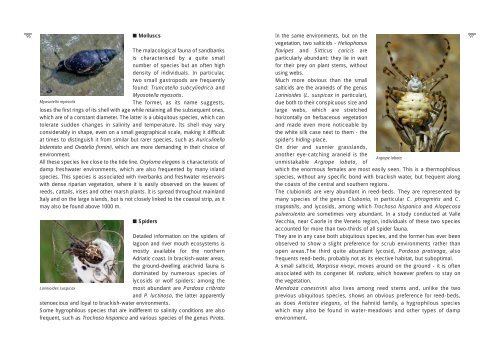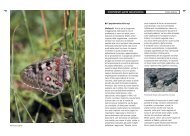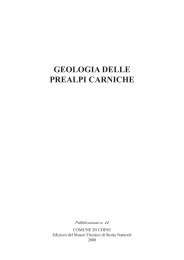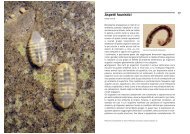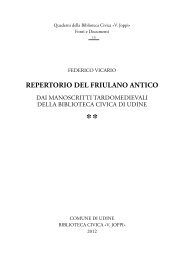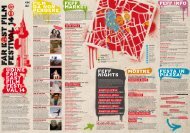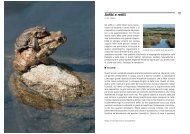Terrestrial invertebrates - Udine Cultura
Terrestrial invertebrates - Udine Cultura
Terrestrial invertebrates - Udine Cultura
Create successful ePaper yourself
Turn your PDF publications into a flip-book with our unique Google optimized e-Paper software.
96<br />
■ Molluscs<br />
The malacological fauna of sandbanks<br />
is characterised by a quite small<br />
number of species but an often high<br />
density of individuals. In particular,<br />
two small gastropods are frequently<br />
found: Truncatella subcylindrica and<br />
Myosotella myosotis.<br />
Myosotella myosotis<br />
The former, as its name suggests,<br />
loses the first rings of its shell with age while retaining all the subsequent ones,<br />
which are of a constant diameter. The latter is a ubiquitous species, which can<br />
tolerate sudden changes in salinity and temperature. Its shell may vary<br />
considerably in shape, even on a small geographical scale, making it difficult<br />
at times to distinguish it from similar but rarer species, such as Auriculinella<br />
bidentata and Ovatella firminii, which are more demanding in their choice of<br />
environment.<br />
All these species live close to the tide line. Oxyloma elegans is characteristic of<br />
damp freshwater environments, which are also frequented by many inland<br />
species. This species is associated with riverbanks and freshwater reservoirs<br />
with dense riparian vegetation, where it is easily observed on the leaves of<br />
reeds, cattails, irises and other marsh plants. It is spread throughout mainland<br />
Italy and on the large islands, but is not closely linked to the coastal strip, as it<br />
may also be found above 1000 m.<br />
■ Spiders<br />
Detailed information on the spiders of<br />
lagoon and river mouth ecosystems is<br />
mostly available for the northern<br />
Adriatic coast. In brackish-water areas,<br />
the ground-dwelling arachnid fauna is<br />
dominated by numerous species of<br />
lycosids or wolf spiders: among the<br />
Larinioides suspicax<br />
most abundant are Pardosa cribrata<br />
and P. luctinosa, the latter apparently<br />
stenoecious and loyal to brackish-water environments.<br />
Some hygrophilous species that are indifferent to salinity conditions are also<br />
frequent, such as Trochosa hispanica and various species of the genus Pirata.<br />
In the same environments, but on the<br />
vegetation, two salticids - Heliophanus<br />
flavipes and Sitticus caricis are<br />
particularly abundant: they lie in wait<br />
for their prey on plant stems, without<br />
using webs.<br />
Much more obvious than the small<br />
salticids are the araneids of the genus<br />
Larinioides (L. suspicax in particular),<br />
due both to their conspicuous size and<br />
large webs, which are stretched<br />
horizontally on herbaceous vegetation<br />
and made even more noticeable by<br />
the white silk case next to them - the<br />
spider’s hiding-place.<br />
On drier and sunnier grasslands,<br />
another eye-catching araneid is the<br />
Argiope lobata<br />
unmistakable Argiope lobata, of<br />
which the enormous females are most easily seen. This is a thermophilous<br />
species, without any specific bond with brackish water, but frequent along<br />
the coasts of the central and southern regions.<br />
The clubionids are very abundant in reed-beds. They are represented by<br />
many species of the genus Clubonia, in particular C. phragmitis and C.<br />
stagnatilis, and lycosids, among which Trochosa hispanica and Alopecosa<br />
pulverulenta are sometimes very abundant. In a study conducted at Valle<br />
Vecchia, near Caorle in the Veneto region, individuals of these two species<br />
accounted for more than two-thirds of all spider fauna.<br />
They are in any case both ubiquitous species, and the former has ever been<br />
observed to show a slight preference for scrub environments rather than<br />
open areas.The third quite abundant lycosid, Pardosa prativaga, also<br />
frequents reed-beds, probably not as its elective habitat, but suboptimal.<br />
A small salticid, Marpissa nivoyi, moves around on the ground - it is often<br />
associated with its congener M. radiata, which however prefers to stay on<br />
the vegetation.<br />
Mendoza canestrinii also lives among reed stems and, unlike the two<br />
previous ubiquitous species, shows an obvious preference for reed-beds,<br />
as does Antistea elegans, of the hahniid family, a hygrophilous species<br />
which may also be found in water-meadows and other types of damp<br />
environment.<br />
97


